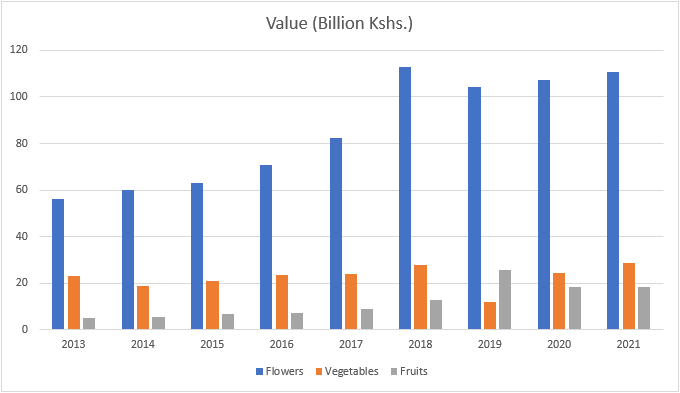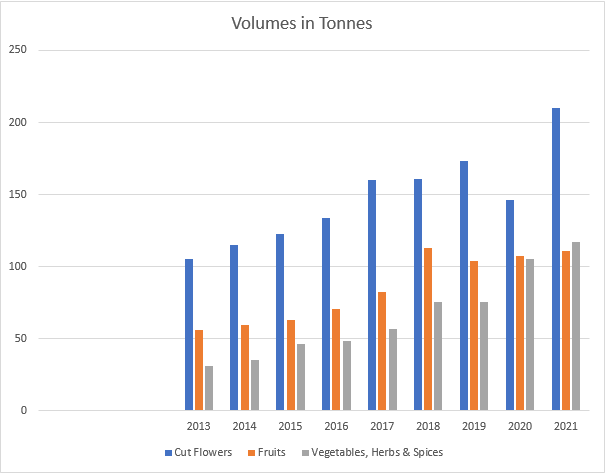Our Portfolio
OUR BROCHURES
View brochures for more about us
Contribution to Kenya’s Economy
Agriculture continues to play a pivotal role in the Kenyan economy accounting for 34 percent of the country’s GDP in 2019, valued at Ksh3.3 trillion (EUR 28.8 billion). The sector employs more than 40 percent of the total workforce and about 70 percent of the rural population (Agricultural Sector Transformation and Growth Strategy, ASTGS 2018). Therefore, agricultural growth and development is critical for Kenya’s overall economic and social development as outlined in the Vision 2030. Yet, the country is experiencing diminishing agricultural production, food security and employment for the growing population.
The horticulture sector was the second best performing in agriculture after the dairy sector, and followed in third position by the tea sector in 2019 contributing 26 percent of the agricultural GDP in the same period. For 2021 the exports totaled Euros 1.25Billion with the same ration: flowers, 72%, vegetables. 18%, fruits 10%.
Exports
The total value of exported horticultural produce in 2020 amounted to EUR 1.18 Million, of which flowers, vegetables and fruits accounted for 73 percent, 17.8 percent and 9.2 percent respectively.
| Cut Flowers | Fruits | Vegetables, herbs and spices | Total | |||||
Volume 000 Tonnes | Value KSh Billion | Volume 000 Tonnes | Value KSh Billion | Volume 000 Tonnes | Value KSh Billion | Volume 000 Tonnes | Value KSh Billion | |
| 2013 | 105.6 | 56.0 | 31.1 | 4.8 | 77.2 | 22.9 | 213.9 | 83.7 |
| 2014 | 114.8 | 59.9 | 35.1 | 5.4 | 70.3 | 18.8 | 220.2 | 84.1 |
| 2015 | 122.8 | 62.9 | 46.2 | 6.6 | 69.7 | 20.9 | 238.7 | 90.4 |
| 2016 | 133.7 | 70.8 | 48.7 | 7.3 | 78.8 | 23.4 | 261.2 | 101.5 |
| 2017 | 160.0 | 82.2 | 56.9 | 9.0 | 87.2 | 24.1 | 304.1 | 115.3 |
| 2018 | 161.0 | 113.1 | 75.5 | 12.8 | 66.7 | 27.6 | 303.5 | 153.6 |
| 2019 | 173.1 | 104.1 | 75.5 | 11.8 | 62.0 | 25.4 | 311.2 | 141.3 |
| 2020 | 146.0 | 107.5 | 105.1 | 18.4 | 62.6 | 24.2 | 313.7 | 150.1 |
| 2021 | 210.1 | 110.8 | 117.3 | 18.4 | 78.1 | 28.5 | 405.5 | 157.7 |


Employment
Employment creation through expansion our sector creates significant employment of both men and in particular women in the rural areas thus helping to stem the rural-urban migration flow. The subsector employs over 350,000 people directly and another 3.5 million indirectly.
Innovation
Currently, the major constraints to horticultural exports are limitations on air cargo space, cost of air freight, and changing patterns of international supply and demand.
Other countries that use sea transport have a competitive market advantage on produce having a high weight: value ratio. Thus, the Kenyan government has recommended that the high- valued produce should be given priority for air freight. At the same time, plans are underway to transport horticultural products by sea and to construct cold-storage facilities. Various concessions also have been instituted for air–freight carriers handling horticultural produce, and internal trade regulations are being reviewed continually with an eye to promoting exports.
Availability of planting materials also has been an obstacle, as most seeds have to be imported, and, therefore, new or improved cultivars have not been available to meet local demand. This problem partly is related to the lack of appropriate stock plants and of a proper marketing system for nursery products.
Consumption
While the export sector has continued to develop and expand rapidly, the local market has not kept pace. Production is limited to small-scale farms in the high- and middle- elevation areas, where rainfall is fairly reliable. These areas, however, have little market information, poor infrastructure (such as access roads), few wholesale marketing centers or cold storage facilities, and generally poor marketing practices. To improve this situation, horticultural processing factories recently have been constructed in Kenya’s major production areas. Demand for horticultural products, particularly leafy vegetables, has continued to increase. Local consumption is estimated to grow 5.6% annually through 2000. Increased urbanization and modern housing have increased demand for ornamental and flowers, with a resulting expansion of flower and ornamental plant nurseries.

